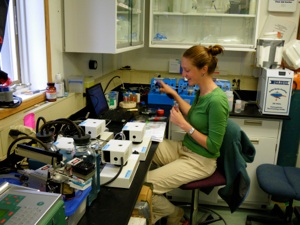Mary Heskel
Plant respiration releases ~60 Petagrams of carbon annually into the atmosphere, is sensitive to multiple environmental variables, and may be the least well-constrained physiological process in models of the global carbon cycle. Understanding how environmental factors, such as seasonality, temperature, soil nutrient availability, and canopy position, affect the processes that regulate plant carbon cycling is essential for predicting future terrestrial carbon balance.
My dissertation aims to characterize autotrophic respiration, specifically the light inhibition of respiration (Kok-effect) and underlying cellular and sub-cellular controls on respiration rates, in Alaskan tundra species. I am also work with the model plant Arabidopsis to investigate ecotypic differences in respiration that correlate with photoperiod and temperature.





